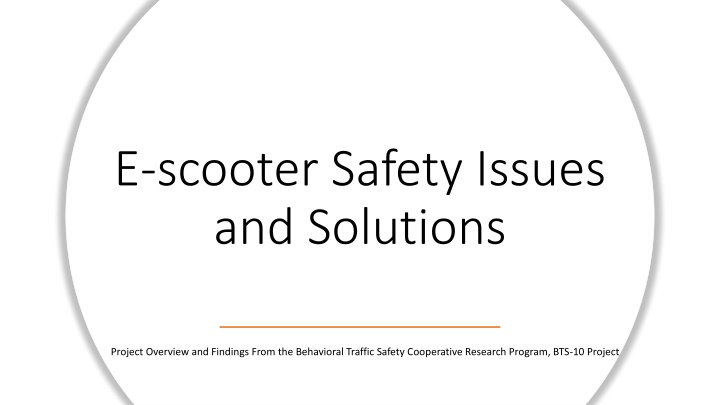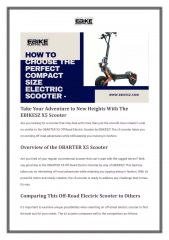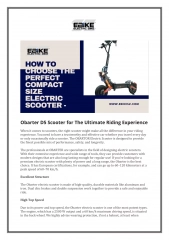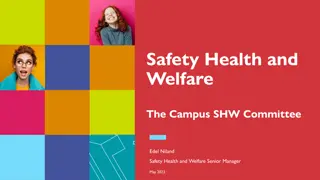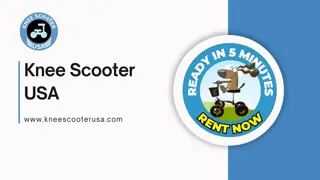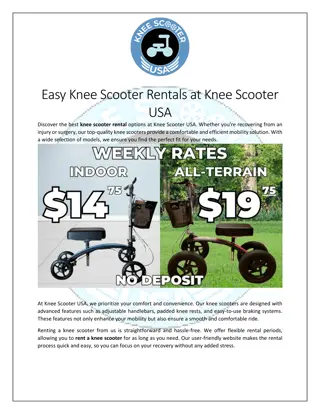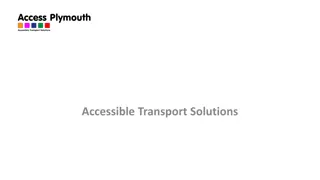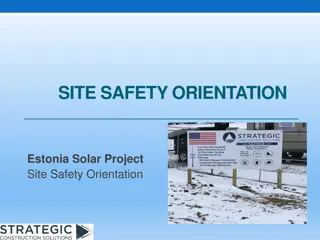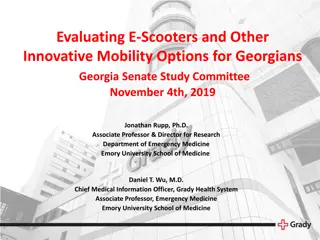E-scooter Safety Issues and Solutions Project Overview
E-scooter safety research project BTS-10 investigated usage patterns, safety concerns, injury data, and safety management practices. The project aimed to identify key safety issues, current practices, and future research needs, emphasizing the importance of a safe and equitable transportation system. Key findings underscored the need for proactive safety measures, human behavior considerations, shared system responsibility, and equitable access to micromobility options.
Download Presentation

Please find below an Image/Link to download the presentation.
The content on the website is provided AS IS for your information and personal use only. It may not be sold, licensed, or shared on other websites without obtaining consent from the author.If you encounter any issues during the download, it is possible that the publisher has removed the file from their server.
You are allowed to download the files provided on this website for personal or commercial use, subject to the condition that they are used lawfully. All files are the property of their respective owners.
The content on the website is provided AS IS for your information and personal use only. It may not be sold, licensed, or shared on other websites without obtaining consent from the author.
E N D
Presentation Transcript
E-scooter Safety Issues and Solutions Project Overview and Findings From the Behavioral Traffic Safety Cooperative Research Program, BTS-10 Project
Slide Deck Overview Introduction Background and project motivation, goals, principles, and evidence base General findings E-scooter usage, context, safety concerns, and injury contributors Current and potential safety management practices and future research needs Takeaways for local micromobility program managers Takeaways for state highway safety officials and policy makers Summary of project deliverables Acknowledgements
Background E-scooters are a form of powered micromobility Source: BTS-10 project team
Project Motivation E-scooter usage continues to grow, both with personally-owned devices and shared ones E-scooters offer convenience, access to transit and other travel modes, and are generally considered low-cost, highly efficient, and low-impact forms of travel As a legitimate and growing transportation mode, e-scooter safety risks deserve attention from transportation policy makers, practitioners, and injury prevention partners Source: National Association of City Transportation Officials, Shared Micromobility in the U.S.: 2019. https://nacto.org/shared-micromobility-2019/
BTS-10 Project Goals This effort used multiple methods of data collection and analysis to describe e-scooter: 1. Current state of use, context, and safety issues; 2. Injury information, including circumstances, severity, and comparison of injury trends to other modes; 3. Safety management practices, both existing and those that may be of interest or are being considered; and 4. Additional research needs. Source: www.pedbikeimages.org / Toole Design
BTS-10 Project Lens: A Safe and Equitable System The project team recognized these key Safe System principles in the development of the research project and subsequent deliverables: E-scooter-related fatalities are unacceptable: Proactive efforts to prevent severe and fatal injuries are critically needed. Humans make mistakes, have limitations, and are vulnerable: Safety management practices must anticipate and accommodate human behaviors and limitations to help avoid serious and fatal injuries. Redundancy is critical and responsibility is shared by system designers: Risk reduction involves all parts of the system working together. An equitable transportation system ensures safe, sustainable, and convenient options for all: Equity principles should be considered within the context of micromobility and support for micromobility in cities and towns.
BTS-10 Project Evidence Base Evidence Description Literature review Reviewed and synthesized 349 studies identified between 2017 and October 2020, including peer-reviewed articles and pilot program reports Practitioner survey Asked about 70 different practices and approaches to safety management; received 207 responses from 85 cities in 38 states with existing micromobility programs. Populus Groundtruth survey Examined e-scooter ridership travel behavior and demographics using a sampling of 18 metro areas in an ongoing travel survey. NC emergency department visit data Compared patient (age 14-59) injuries from 487 e-scooter riders, 1,581 bicyclist, and 1,440 pedestrians from same Emergency Departments (in 5 NC counties) and time period. Field observations of e-scooters and cyclists Examined social and environmental factors affecting or constraining e-scooter rider behaviors related to sidewalk riding and decisions around parking. Gathered field and video data from two cities in October 2021. Interviews with micromobility program managers Interviewed staff from five city agencies to help fill gaps identified through the literature review and practitioner survey related to community engagement, engagement with State Highway Safety Offices (SHSOs), planning and operations, and data and analysis.
Practitioner Survey Participant Highlights Position Type Organization Type Source: BTS-10 project team
Field Data Collection Highlights Source: BTS-10 project team
General Findings: State of use, context, and safety issues Characteristics Demographics Pedestrians E-scooter Riders Bicycle Riders More females than males; all ages and income levels. Slightly more males than females (though highly variable by location); majority of shared e-scooter users are between the ages of 18-35 years old; skew white and middle-income. Riding speed can be limited by policy or geographic location; range from 10-15 MPH. Seasonal ridership similar to bicycles; helmet use is lower for e-scooters than for bicyclists; more likely to be using shared devices than owned devices, in comparison to bicycles. Prefer separated bike facilities over sidewalks when provided the option. Many more male riders than female riders; average age is slightly older than e-scooter riders and higher income. Speed range Walking speed is typically 3.5 ft/sec or 2 MPH. Ranges from 8-13 MPH for traditional bikes and higher for e- bikes (10-15 MPH). Similar to e-scooter riders, though less nighttime ridership and longer average trip length. Travel behaviors More likely to be accessing transit than e-scooter or bicycle modes. Facility preferences Prefer sidewalks when provided the option. Prefer separated bike facilities when provided the option.
General Findings: E-scooter injury circumstances and contributing factors Characteristics Pedestrians E-scooter Riders Bicycle Riders Impairment patterns In 2020, about 10% of non-fatally injured pedestrians and 31% of fatally injured pedestrians are reported as being alcohol or drug impaired. 16% of drivers involved in pedestrian crashes were impaired, not counting hit and run incidents where driver condition is unknown (National Center for Statistics and Analysis 2022). About 6% of non-fatally injured e-scooter riders reported as being alcohol or drug impaired. Of the 69 known e-scooter fatalities in the US, an estimated 4% involved reportedly impaired riders, another 4% were ruled to have not involved impairment, and the remaining cases were unknown or missing impairment data (Cherry et al 2022). In 2019, about 6.5% of non-fatally injured bicyclists and 20% of fatally injured bicyclists (involved in motor vehicle crashes, only) were reported as being alcohol or drug impairment. Around 12% of drivers involved in bicycle crashes were impaired, not counting hit and run incidents where driver condition is unknown (National Center for Statistics and Analysis 2021). Data on falls and crashes with modes other than drivers are lacking, but most fatal injuries involve a motor vehicle. Injury profile Data on falls and crashes with modes other than drivers are lacking, but most fatal injuries involve a motor vehicle. More falls and fewer motor vehicle involved crashes than other modes: 90% of injuries occur off road and/or do not involve a motor vehicle; 70% of fatal injuries involve a motor vehicle. May be more vulnerable to roadway surface irregularities (including stormwater grates, rail crossings, cracks, etc.) than bicycles. Hardware failure or malfunction and rider inexperience are also contributing factors.
Proper helmet-wearing reduces public healthcare costs, but current e-scooter helmet use is low Head injuries, including traumatic brain injuries, are the most common type of e-scooter injury requiring medical treatment (28-40%). Fractures, particularly involving the lower arm and wrist, are also common (25-31%). Studies of injured pedestrians in one state found that more than half rely on publicly funded healthcare programs. This study and others have observed e-scooter helmet use is low, and consistently lower than bicyclist helmet use.
General Findings: Safety management practices Wide range of practices taking place Very few robust evaluations of safety interventions and/or impacts Source: BTS-10 project team
What makes e-scooter riders safe? Safe System principles of: Separation of road users (in space or in time of facility use) Spaces for practice and opportunities to gain experience Inclusive, friendly streets designed for e-scooter usage Slow vehicle speeds Source: BTS-10 project team
What can individual riders do to protect themselves? Source: BTS-10 project team
Toolbox offering: A summary of safety management practices Domain Description of Safety Management Practice Provides a description of the practice and indicates the typical agency lead (S = SHSO; D= State DOT; L = Local agency); also links to the relevant section of the final report to find additional resources or supporting literature Current Level of Adoption Current Strength of Injury Prevention Evidence Based on the BTS-10 literature review and expert input, indicates the current evidence base supporting the practice: Categorizes the practices in terms of which primary Safe Systems area it falls under: Based on the BTS-10 survey and literature review, indicates low, medium, or high levels of current adoption Safe Roads No demonstrated effectiveness; Safe Vehicles Safe Speeds Limited or no high-quality evidence; Safe People Post-Crash Harm Reduction Promising/ Likely effective; or Safety Evaluation High demonstrated effectiveness
General Findings: Additional research needs Studies on the experiences, attitudes, and perceptions, and injury outcomes of people with disabilities in relation to e-scooters Studies on the experiences, attitudes, and perceptions, and injury rates and outcomes of people in different socioeconomic groups (age, gender, race, ethnicity, income) Studies/evaluations of local e-scooter practices related to speed management, pavement quality management/maintenance, design of transition zones, parking policy/design, and communications/engagement techniques Studies/evaluations of the equity of various e-scooter practices (geofencing, service restrictions, enforcement, data or other program and permitting requirements) Evaluations, resources, or guidance on equitable community practices to build civic engagement in e-scooter programs, network planning, and policy decisions
Key Takeaways for Local Micromobility Program Managers 1. Micromobility parking is a civil rights issue and a safety issue Planning for equitable allocation of parking infrastructure is a must 2. Micromobility programs will not succeed if riders have bad experiences or are injured Proactive community engagement and hazard identification can pre-empt injuries and complaints 3. Seek ways to mitigate harmful behaviors, as well as reduce the harm when injuries do occur Partner and plan for harm reduction and addressing the deadliest combinations of risk factors Community engagement offers opportunities to address equity and build a culture around safety
Micromobility parking is a civil rights issue and a safety issue Public rights-of-way and facilities are required to be accessible to persons with disabilities through the following statutes: Section 504 of the Rehabilitation Act of 1973 (Section 504) (29 U.S.C. 794) and Title II of the Americans with Disabilities Act of 1990 (ADA) (42 U.S.C. 12131-12164). These statutes prohibit public agencies from discriminating against persons with disabilities by excluding them from services, programs, or activities. These statutes mean that the agency must provide pedestrian access for persons with disabilities to the agency's streets and sidewalks, whenever a pedestrian facility exists. Regulations implement this requirement by imposing standards for accessible features such as curb cuts, ramps, continuous sidewalks, and detectable warnings." (FHWA). Planning for parking helps preempt ADA concerns and complaints and reduce tripping and fall hazards Where you place the parking matters Source: BTS-10 project team Source: BTS-10 project team
Plan for equitable allocation of parking infrastructure Source: BTS-10 project team Source: www.pedbikeimages.org/ TREC Source: BTS-10 project team
Micromobility programs will not succeed if riders have bad experiences or are injured Percent of injuries involving first time or novice riders: 30% Some agencies and operators indicated that injured riders quit riding after an incident Source: www.pedbikeimages.org/ Toole Design Group
How can communities be proactive about e-scooter safety? Is your risk reporting program adequately staffed? Do you have a system in place to provide equitable responses? Do you have a system in place to respond to systemic issues? Are you leveraging opportunities for community members to share data? Is your roadway network ready for e-scooters? Pavement conditions Transition zones Separated bicycle facilities
Proactive risk identification can pre-empt injuries and complaints 90% of e-scooter injuries occur off road and/or do not involve a motor vehicle Screen the network for: Stationary objects: curbs, light poles, manhole covers, grates, railroad tracks Poor roadway surface conditions (potholes, pavement cracks, lips) Topography challenges Poor lighting Source: BTS-10 project team Source: www.pedbikeimages.org/ Reed Huegerich
Key issue: pavement hazards at rail crossings, intersections, and transitions to sidewalk Source for all photos on this slide: BTS-10 project team
Connected, low stress bike networks also work for e-scooter safety and perceptions of comfort Roads with bike lanes are associated with: Fewer e-scooter injuries Less sidewalk riding More satisfied e-scooter riders Source: Bird Report: A Look at E-scooter Safety, April 2019
Example: Denver data coordination for systemic risk detection Map Showing E-scooter Trips from 2018-2022 in Denver, CO. Source: Ride Report, 2022
Toolbox offering: E-scooter risk assessment tool Provides a list of discussion prompts Can be used in road safety audit like activities, or could be integrated into routine travel surveys Source: BTS-10 project team
Mitigating harmful behaviors Humans being humans, we are likely to continue seeing: Social (double) riders Stunt/trick riders Wrong-way riders Inexperienced or confused road users Impatient or indifferent road users Impaired road users Riders without helmets Not all these behaviors pose serious injury risks, and not all occur at the same frequency Some of these behaviors can be mitigated through thoughtful roadway design practices and community engagement Source: BTS-10 project team Source: BTS-10 project team
A particularly dangerous combination What can be removed from this dangerous mix? Binge drinking opportunities Austin, TX example: experimented with a car- free zone at night in entertainment district where e-scooter ridership is high E- scooters mixing with traffic Young adults Nashville, TN example: heightened impairment screening via tech prior to scooter rental Cars and trucks moving at lethal speeds Source: BTS-10 project team
Community engagement offers opportunities to address equity and build a culture around safety Public engagement plans can focus on: Setting and clarifying rules of the road and safe places for e-scooter use or practice Building social norms of courtesy and empathy among all road users Establishing ambassador programs to onboard newcomers, model leadership, and grow helmet-use culture Identifying alternatives to penalties and punishments that may perpetuate inequities Partnering on helmet giveaways and helmet access programs Engaging with system designers on safety policies, plans, and approaches to address e- scooter needs Source: District of Columbia Source: City of Santa Monica Source: City of Spokane
Key Takeaways for State Highway Safety Officials and policy makers 1. Definitions and policy support Local agencies need state-level support in defining emerging devices and prioritizing the safety of vulnerable road users in policy and legislative documents 2. Data collection and data improvement State leadership is needed to improve e-scooter safety data standards, data collection, and support for local program evaluation 3. Program and partner support State Highway Safety Offices can play a key role in providing local funding and program support as well as coordinating with key partners, such as Emergency Service Providers, to integrate and share plans and safety data
Definitions and policy support are currently lacking in most states Many discrepancies in state laws pertaining to e-scooters and classification (e.g., as a pedestrian, bicycle, moped, motorcycle, or unique mode of transport) State laws may not align with neighboring states and/or local municipalities and ambiguity may lead to rider confusion regarding legal operating environments Vague or non-existent classification makes classification and consistency in police reported crash data more challenging Source: pedbikeinfo.org/Toole Design Group
E-scooter data gaps identified Lack of data on rates, characteristics, and prevalence of less-severe injuries (not captured in police or medical data systems) Lack of measures of e-scooter access, exposure, and safety/comfort outcomes (relative to other modes of travel) disaggregated by age, gender, race, ethnicity, and income Lack of data standards and case definitions for e-scooter related falls, injuries, and other safety outcomes Lack of consistent e-scooter exposure data and monitoring practices Lack of data integration to link injury outcomes to spatial/roadway context Lack of data on privately owned e-scooter usage, exposure to risk, and safety outcomes Source: pedbikeinfo.org/Toole Design Group
Toolbox Offering: Data improvement support Principles of quality data Overview of key data sources and elements for examining e-scooter risks Community checklist (shown in previous slide) Protocols and data collection forms for manual and video data collection (provided in Final Report) Source: BTS-10 project team
E-scooter program and partner support State Highway Safety Offices (SHSOs) can play a role in: Engaging Traffic Records Coordinating Committees (TRCCs) on e-scooter data improvements Sharing and standardizing best practices in police and healthcare system e-scooter injury coding and crash reporting Assisting communities in getting funding for safety programs, community engagement efforts, and data improvements Toolbox case studies: Chicago, IL; Denver, CO, Nashville, TN; Portland, OR; and Washington, DC Source: UNC Highway Safety Research Center, 2020
BTS-10 Research Products for additional info, guidance, and resources 1. Research Results Digest: https://nap.nationalacademies.org/catalog/26756/e-scooter-safety-issues-and- solutions 2. Toolbox: add link when available or direct to main project page Fundamental concepts related to e-scooter safety Promising practices to improve e-scooter safety Data tools and methods for safety evaluation Additional resources and examples 3. Final Report: add link when available or direct to main project page 4. Implementation Guidance Memo: add link when available or direct to main project page
Project Team Acknowledgment This project involved contributions from the following individuals: Laura Sandt, UNC-HSRC (Principal Investigator) Alyson West, UNC-HSRC Katie Harmon, UNC-HSRC Kristin Blank, UNC-HSRC Meg Bryson, UNC-HSRC Tab Combs, UNC-DCRP Rebecca Sanders, Safe Streets Research & Consulting Charles T. Brown, Equitable Cities Regina Clewlow, Populus Stephanie Seki, Populus Chris Cherry, UTK Student Research Assistants: Emma Sexton, Nitesh Shah, Yi Wen, Mojdeh Azad, and Ashkan Neshagarian, all at UTK
Acknowledgment This presentation is a deliverable of Behavioral Traffic Safety Cooperative Research Program (BTSCRP) Project BTS-10. BTSCRP is sponsored by the Governors Highway Safety Association and funded by the National Highway Traffic Safety Administration. BTSCRP is administered by the Transportation Research Board (TRB), part of the National Academies of Sciences, Engineering, and Medicine. Any opinions and conclusions expressed or implied in resulting research products are those of the individuals and organizations who performed the research and are not necessarily those of TRB; the National Academies of Sciences, Engineering, and Medicine; or BTSCRP sponsors.
